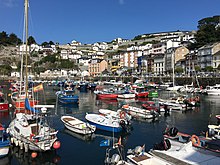Luarca
 From Wikipedia - Reading time: 5 min
From Wikipedia - Reading time: 5 min
Luarca/Ḷḷuarca | |
|---|---|
 | |
 | |
| Coordinates: 43°32′32″N 6°32′9″W / 43.54222°N 6.53583°W | |
| Country | |
| Autonomous community | |
| Province | Asturias |
| Comarca | Comarca Vaqueira |
| Municipality | Valdés |
| Area | |
• Total | 5.84 km2 (2.25 sq mi) |
| Highest elevation | 110 m (360 ft) |
| Population (2021) | |
• Total | 4,670 (parish) |
| • Density | 799.7/km2 (2,071/sq mi) |
| Demonym | luarqués/luarquesa |
Luarca (Ḷḷuarca in Asturian and coofficially[1]) is a parish and the principal town in the municipality of Valdés in Asturias, Spain.
Luarca (town) is a fishing and pleasure port. Luarca (parish) had a population of 4,670 (2021), and an area of 5.84 km2 (2.25 sq mi). The town is 90 km (56 mi) from Oviedo, the capital of Asturias. The Nobel laureate for Medicine in 1959, Severo Ochoa, was born in Luarca. It is well known for its beautiful architecture, landscapes, gastronomy, and tourist attractions. San Timoteo festivities usually attract thousands of people every August.
Museo del Calamar Gigante, said to be the world's only museum dedicated to the giant squid, was based in the town from its opening in 2010 to its destruction by a storm in 2014; it reopened at a new location in the centre of town in 2022.
Way of St. James
[edit]The Way of St. James named The Northern Way (Camino de la Costa) passes Luarca.
Economy
[edit]Fishery and agriculture have dominated the region for hundreds of years. Luarca is home to the ALSA bus company.
Climate
[edit]The town experiences warm summers and relatively mild winters, but strong storms occur in autumn.
Points of interest
[edit]- The Fishery Harbour
- Palace of the Marquis of Ferrera
- Lighthouse of Luarca
- Giant Squid Museum


Notable people
[edit]- Severo Ochoa (1905–1993), physician and biochemist, Nobel prizewinner
Villages in Luarca (parish)
[edit]- Luarca (town): population 3,620 (2021)
- Almuña: 870 (2021) 43°32′01″N 6°31′29″W / 43.53371°N 6.52485°W
- Fontoria: 92 (2021) 43°31′28″N 6°31′42″W / 43.52447°N 6.52833°W
- Barceḷḷina: 87 (2021) 43°32′27″N 6°31′08″W / 43.54080°N 6.51880°W
- Portizuelo: 1 (2021)
References
[edit]External links
[edit]- City page
- [1] Asturian Map]
- Luarca. The White Town of the Green Coast
 KSF
KSF